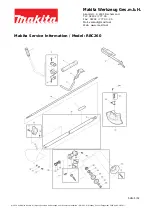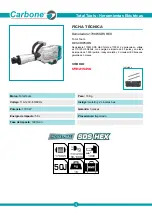
ETO ES61-30-13-LO5
Safety Information
© Atlas Copco Industrial Technique AB - 9834 4752 00
5
Intended Use
This product is designed for installing and removing threaded
fasteners in wood, metal or plastic. Indoor use only.
No other use permitted.
Product Specific Instructions
Installation
General Installation Safety
Refer installation to qualified personnel only.
Hang the tool securely, by for example using a balancer.
When using a suspension yoke, check that it is in good con-
dition and correctly fastened.
Always connect the system to an earthed outlet. Always
make sure that the mains plug is disconnected and the con-
troller is turned off before connecting or disconnecting the
tool cable.
Operation
Dual Trigger
Dual trigger (Recommended to use during
operation)
WARNING Crushing Hazard
The Dual trigger forces the user to use both hands to op-
erate the tool. If not used, the operator can accidentally
start the tool while adjusting the crowfoot, thus resulting
in a serious hand injury.
►
Make sure the tool cannot be started once the Dual
trigger has been released.
►
Always test the tool by first releasing the trigger of
the Dual trigger, then push the trigger of the tool. If
the tool starts; stop working.
Special Precautions for Open End Nutrunners
WARNING Crushing Hazard
Never reach into the open-end head. Moving parts can
crush and cut. Keep hands and fingers away from mov-
ing parts.
General Instructions
The tool may only be used together with the associated
torque reaction bar, which is adapted to the screw joint appli-
cation concerned.
WARNING Crushing Hazard
Check the rotational direction of the tool before start! A
start in an unexpected rotational direction can cause
bodily injury or property damage. Moving parts can
crush and cut.
►
Make sure that the rotational direction of the tool is
correct before starting the tool.
►
Keep hands and fingers away from moving parts.
General Operation Safety
•
Due to entanglement risk, do not wear gloves.
•
Be prepared of the reaction force which will occur
when the tool is used.
Always support the tool’s handle
securely in the direction opposite to the spindle rotation,
in order to reduce the effect of sudden torque reaction
during final tightening and initial loosening.
•
Never hold the drive, socket or drive extension.
•
Operators and maintenance personnel must be physi-
cally able to handle the bulk, weight and power of the
tool.
•
If possible, use a suspension arm to absorb the reac-
tion torque. If that is not possible, side handles are
recommended for straight-case and pistol-grip tools;
reaction bars are recommended for angle nutrun-
ners.
It is recommended to use a means to absorb the re-
action torque above 4 Nm (3 lbf.ft) for straight-case
tools, above 10 Nm (7.5 lbf.ft) for pistol-grip tools, and
above 60 Nm (44 lbf.ft) for angle nutrunners.
•
Serious injury can result from over-torqued or un-
der-torqued fasteners.
Assemblies requiring a specific
torque must be checked using a torque meter. So-called
“click” torque wrenches do not check for potentially
dangerous over-torqued conditions. Over-torqued or un-
der-torqued fasteners can break, loosen or separate. Re-
leased assemblies can become projectiles.
•
Use only power or impact sockets in good condition.
Do not use hand sockets.
•
When using a power tool, the operator may feel dis-
comfort in the hands, arms, shoulders, neck, or other
parts of the body.
Vary between appropriate postures
throughout the work day, maintain a secure footing and
avoid awkward or off-balance postures.
•
Repetitive work motions, awkward positions and ex-
posure to vibration can be harmful to hands and
arms.
If numbness, tingling, pain or whitening of the
skin occurs, stop using tool and consult a physician.
•
Take caution when operating in confined spaces.
Be-
ware of crushing hands between tool and workpiece.
•
High sound levels can cause permanent hearing loss.
Use hearing protection as recommended by your em-
ployer or occupational health and safety regulations.
•
Ensure that the workpiece is securely fixed
.






































